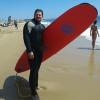@Eratosthenes
That is extremely interesting, I had no idea that Gunkelman was into float tanks also... NFB and float tanks are some of my main intrests  . I have the new Zen Float tent but the pump and heating system keeps breaking down for me (faulty GFCIs I think), they say they are working on a new upgrade to fix those problems but until then I dont think I can use my tank
. I have the new Zen Float tent but the pump and heating system keeps breaking down for me (faulty GFCIs I think), they say they are working on a new upgrade to fix those problems but until then I dont think I can use my tank  . I have been thinking about how to record the EEG in the water, I have not come up with any clear solution so far, Gunkelman mentions using glue and petroleum jelly but that sounds kind of nasty hehe, he also mentions new dry electrodes and that sounds a lot more promising, I wonder if it would work with the Q-wiz and bioexplorer setup though... Maybe we can figure out a way to hack it somehow, if anyone has ideas on that I am highly interested, I think it would be very useful for consciousness research.
. I have been thinking about how to record the EEG in the water, I have not come up with any clear solution so far, Gunkelman mentions using glue and petroleum jelly but that sounds kind of nasty hehe, he also mentions new dry electrodes and that sounds a lot more promising, I wonder if it would work with the Q-wiz and bioexplorer setup though... Maybe we can figure out a way to hack it somehow, if anyone has ideas on that I am highly interested, I think it would be very useful for consciousness research.
I have already found out that you can buy underwater headphones and such so that should not be a problem, maybe speakers can be used too but the sound might become a bit distorted if your ears are under water, perhaps if you saturate the water with enough salt your ears could float above the water line, I am not sure really. Some people use float pillows that could perhaps keep the ears above water and then it would be ok to use speakers I think which would be a bit easier.
I think the float tank probably makes it a whole lot easier to enter the theta state, I think I have had that happen to me in the tank but no way of knowing for sure without recording the EEG. I have been thinking about what kind of NFB setups to use, perhaps it could be a feedback signal that activates when you are out of the theta state, and it guides you back to it and then becomes silent as long as you remain there, that way it would not be so disturbing and would only activate when needed, eventually perhaps you would learn how to access this state so well that feedback would hardly be needed any more.
I know that Tom Budzynski used similar methods that Gunkelman described, for similar purposes but without floatation tanks, you can find out more about it here: http://www.futurehea...100215-169.html
Here are some of my notes from this talk:
Theta training:
-IN the 70s Tom B. wanted to get rid of "the voice" that stopped depressed people from self-affirming, current studies showed that as you lower cortical arousal information processing changes from being critical to being more accepting, the Kung tribe make their patients dance until they collapse and then the shaman come and help them, other people have people go into deep trances before doing rituals, you have to get the conscious mind out of the way, people who use ayahuasca and other drugs all know these rules, they would go into special states where they could see the future
-There are many brain-states that are mostly unexplored by science, there are things you can achieve, Aldous Huxley talked about "the valve", getting rid of this opens your mind to possibilities
-Jim Hardt has identified brain-states associated with E.T. contact, he opens the brain up with alpha, you idle part of the neocortex which lets you get to lower/more primitive brain functioning, our ancestors were much more tuned in to these influences, we shut down the valve with our left-brain development
-Tests of successful CEOs showed they are highly intuitive, they are sort of psychic, their decisions are based on flimsy data a lot of the time, they use intuition instead
-The right brain has special properties
-Tom B. studied left handers, they can be double left or double right, Mozarts handwriting was terrible and his grammar was bad, it also gave him child-like qualities, he made the left-brained people jelous, genius is often identified in the right hemisphere of the brain
-What is a double right? Has right-brain functions in both hemispheres, a double left is opposite - double rights in sports, entertainment, artists etc, right brains get in trouble because they dont obey the law, frontal lobes inhibit this but they can only do so much
Twilight learning:
-EEG over the left hemisphere, get this to go to sleep, wait until it gets to theta (using a pink-noise which sounds like a wave kind of), when you do this the machine detects the state and it starts a tape-recorder, when you go out of theta the tape-recorder stops, if you go to sleep then it gets louder (bump-effect)
I think in general the left hemisphere is more concerned with "the narrative", which is our ongoing representation of what we think is happening, and can therefore perceive in distorted ways if these representations are inaccurate in any way, the right hemisphere deals more with "the unknown" which is not yet expressible in language, it has more to do with feeling, intuition etc. I suppose you might say conscious/unconscious although that is not quite accurate since we can be quite conscious of what the right hemisphere perceives, I think it is more like it is in an early stage of coming in to consciousness which makes sense I think since we first cannot describe in language what we perceive, these are the ineffable and mysterious qualities of life.
Elkhonon Goldberg (student of Luria) has developed a model of the hemispheres which proposes that the right hemisphere deals primarily with novelty, while the left deals more with routine, this makes sense I think and can for example explain why the left hemisphere seems to be the linguistic hemisphere, because in most adults language is very much a learned routine. It has been found that novel tasks preferably activate the right, frontal hemisphere and as the task becomes increasingly routine the activation moves to the left and to the back of the brain, this means that as we build routines they become like "mental machines" that we can store in the left back of the head... This would include our ongoing narrative of life since we are practicing this all the time and use it to explain everything, this is neither good nor bad I think but a necessary fact of life, the problem I think arises when these representations are dysfunctional for living, they become like inner voices that tell us what we can and cannot do, like sub-personalities (in psychoanalytic terms the psyche is inhabited by sub-personalities).
I think what these theta re-programming techniques is attempting to do then is to start editing the ongoing narratives towards a chosen end, which takes the form of the new recording that is played. I guess it would be like attempting to cultivate the ecology of sub-personalities (I like thinking about the psyche in these terms, as sub-personalities rather than "scripts", I dont like the more modern cognitive psychological terms which treats people like computers, which I dont think we are really...but that might not be relevant, I guess you can call them scripts or whatever).
This is an interesting approach I think and I think it would be worthwhile to explore it. The way I see it however it is a kind of "top-down" approach of attempting to enforce an effect in the psyche, because the conscious mind or ego will choose what it thinks the change should be and then attempts to create this change, that might be alright and useful sometimes.
I think I prefer a more "bottom-up" approach though, which would be more to open up and allow direct experience to transform you, this approach would admit that the ego is necessarily limited and might not know what is best and instead seek the solution in the unknown, in the chaos that lies beyond the ego representations so to speak. How I think this could be practiced is to also use flotation tanks and theta feedback for example, but to get to those states in order to have experiences that in turn end up transforming the narratives, mystical experiences if you will or experiences of places beyond the ordinary reality. A shamanic journeying or Gnostic initiation approach into the unknown realms of mystery and wonder. In modern psychological terms it would be more like the Jungian approach of the individuals journey towards wholeness.
I guess it might be a matter of philosophical preferences, I guess both approaches may work, and I intend to attempt to explore both, in time as I get my flotation tank up and running and perhaps also some way of recording the EEG in those states.
I would be curious to hear more about your experiences with hypnosis, I could be entirely confused in the way I perceive this of course, I have no experience with hypnosis so I would like to hear more about that

.































 This topic is locked
This topic is locked
























